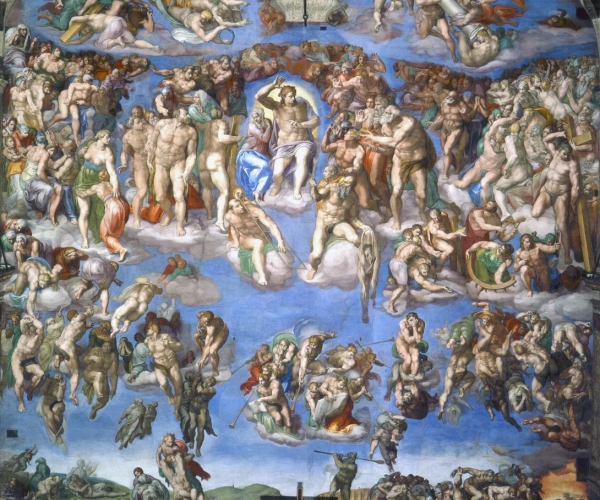Last Judgment (1) 1537-41
Michelangelo Buonarroti's "Last Judgment" is a monumental fresco located in the Sistine Chapel in Vatican City. Created between 1537 and 1541, this masterpiece depicts the Second Coming of Christ and the final judgment of souls, a theme that has been commonly portrayed in Christian art. What sets Michelangelo's interpretation apart is his unique and awe-inspiring portrayal of dynamic figures and emotional intensity.
The composition of the artwork is striking, with Christ positioned at the center, exuding divine authority as he separates the blessed from the damned. The figures are arranged in a swirling and tumultuous manner, creating a sense of movement and drama. The muscularity and physicality of the figures reflect Michelangelo's mastery of human anatomy, contributing to the overall dramatic impact of the scene.
Michelangelo's use of color, light, and shadow adds to the visceral impact of the artwork. The intense colors and contrasts enhance the emotional weight of the narrative, intensifying the viewers' experience of the divine judgment. The artist's skillful manipulation of light and shadow creates a sense of depth and three-dimensionality, drawing the observer into the harrowing scene.
In addition to the raw emotional power of the composition, Michelangelo's "Last Judgment" is also notable for its complex symbolism and the intricate detailing of the multitude of figures populating the fresco. Each figure, whether saintly, redeemed, or damned, exhibits a unique expression and posture, contributing to the overall narrative of the final judgment.
The impact of "Last Judgment" extends beyond its visual representation. The artwork has been the subject of both admiration and controversy due to the nudity and depictions of the human form, with some viewers finding the portrayal of the naked figures scandalous while others appreciate the artistic and spiritual significance of the human body within the Christian narrative.
Overall, Michelangelo's "Last Judgment" remains a compelling and visually arresting masterpiece, inviting viewers to contemplate themes of redemption, salvation, and the eternal struggle between good and evil. Its enduring impact continues to resonate with audiences, making it a significant and timeless contribution to the canon of Western art.







No Comments Yet...